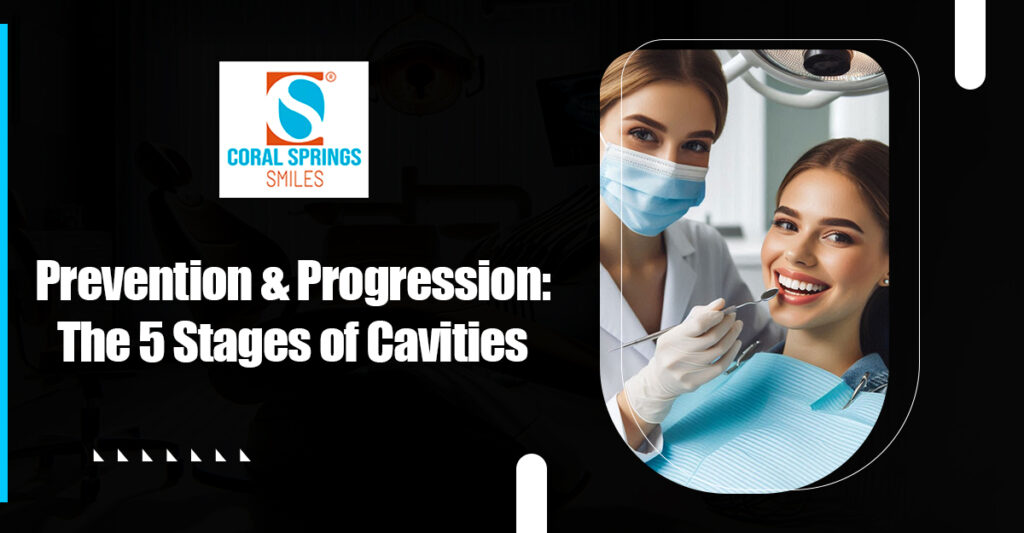
Cavities, or dental caries, are one of the most common oral health issues, affecting people of all ages, understanding how cavities develop and progress can help you take proactive steps to prevent them. At Coral Springs Smiles, we believe in empowering our patients with the knowledge they need to maintain healthy, cavity-free smiles.
Let’s explore the five stages of cavities and how you can prevent them.
Stage 1: Demineralization
The first stage of cavity formation is demineralization, where the enamel—the outermost layer of your teeth—begins to weaken. This typically happens due to a buildup of plaque and the acids it produces. Plaque forms when bacteria in your mouth break down sugars from the food you eat. These acids start to erode the minerals in the enamel, leading to white spots or streaks on the surface of your teeth.
At this stage, cavities can be reversed with proper dental care, such as regular brushing, flossing, and fluoride treatments. Fluoride helps remineralize the enamel, making it more resistant to acid attacks.
Prevention Tip: Minimize your intake of sugary and acidic foods, and drink plenty of water to wash away food particles and bacteria. Regular dental cleanings can help eliminate plaque before it causes damage.
Stage 2: Enamel Decay
If the demineralization process continues without intervention, the enamel will start to break down further. The white spots on your teeth may turn brown as the damage progresses. At this stage, the tooth’s protective enamel layer has been compromised, and small holes or cavities begin to form.
While enamel decay isn’t reversible, it can still be treated before it causes more serious problems. The dentists may recommend a filling to repair the damaged enamel and prevent the cavity from worsening.
Prevention Tip: Consistently brushing with fluoride toothpaste and flossing can help slow or stop the progression of enamel decay. Don’t skip your routine dental visits, as early detection is key to preventing more advanced cavities.
Stage 3: Dentin Decay
Once the cavity reaches the dentin, the layer beneath the enamel accelerates. Dentin is softer and more porous than enamel, so it erodes more quickly. As the decay spreads, you may start to experience sensitivity to hot, cold, or sweet foods and drinks.
At this point, the damage is more severe and cannot be reversed. A filling is typically required to stop the progression and protect the tooth from further decay. In some cases, if the cavity is large, more advanced treatments like crowns may be necessary to restore the tooth’s strength.
Prevention Tip: Address sensitivity or discomfort early on by visiting your dentist. They can recommend treatments to prevent the decay from spreading to deeper layers.
Stage 4: Pulp Infection
The pulp is the innermost part of your tooth, containing nerves and blood vessels. Once the decay reaches this stage, it can lead to a painful infection. You might experience sharp pain, swelling, or an abscess—a pocket of pus caused by the infection.
At this stage, the tooth cannot heal on its own, and immediate intervention is required. A root canal is typically the recommended treatment to remove the infected pulp and save the tooth. In some cases, if the infection is too severe, the tooth may need to be extracted.
Prevention Tip: Regular dental checkups allow your dentist to catch cavities before they reach the pulp. If you experience any sudden pain or swelling, don’t wait—seek treatment immediately to avoid further complications.
Stage 5: Abscess Formation
If a pulp infection is left untreated, it can lead to an abscess. This is a serious dental issue where pus accumulates at the root of the tooth, causing severe pain and swelling. The infection can spread to surrounding tissues, and in rare cases, even lead to life-threatening complications if it enters the bloodstream.
An abscess requires immediate attention. Your dentist may drain the abscess and perform a root canal to remove the infection. In severe cases, the tooth may need to be extracted, and antibiotics may be prescribed to clear the infection.
Prevention Tip: Don’t let cavities reach this stage. By following a diligent oral care routine and visiting your dentist regularly, you can prevent cavities from escalating into painful abscesses.
Conclusion
Cavity prevention starts with good oral hygiene and regular dental care. By understanding the five stages of cavity progression, you can take control of your dental health and stop cavities in their tracks before they lead to more serious problems. At Coral Springs Smiles, we’re here to help you protect your teeth at every stage. Schedule an appointment today to keep your smile healthy and cavity-free!



